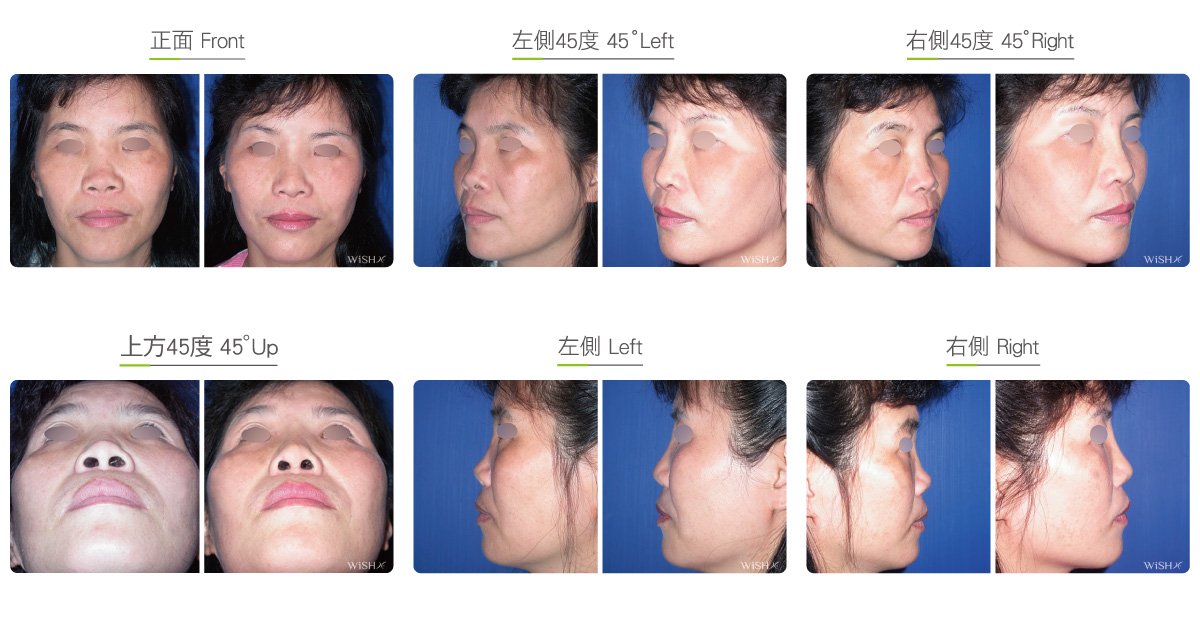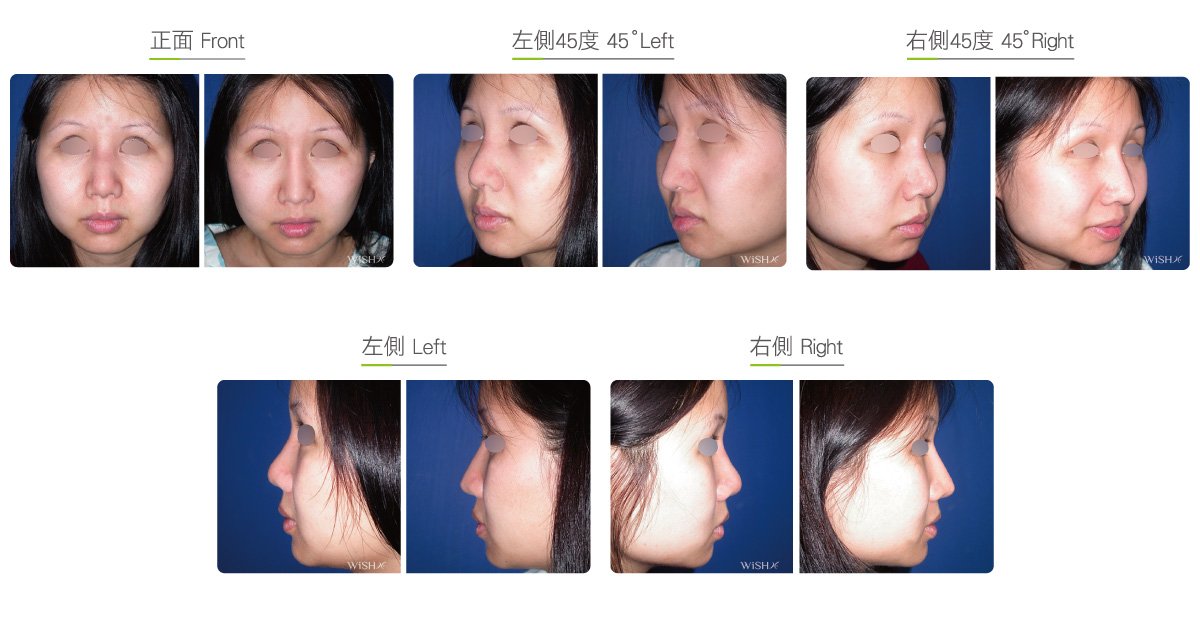Homologous Costal Cartilage Rhinoplasty
Compared with autologous costal cartilage rhinoplasty, homologous costal cartilage rhinoplasty requires the same surgical procedures, but there is no need to harvest ribs from the patient; however, it is based on the proportionate homologous costal cartilage purchased from manufacturers, which not only curtails surgical duration but also avoids chest wall scars. At present, homologous costal cartilages that can be legally purchased in Taiwan are all imported from the US and are derived from legal organ donors. Such ribs have undergone multiple infectious disease and immunity examination procedures, deactivation by gamma rays, sterilization, and purification and would therefore not incur rejection reactions. The aforementioned procedures are approved by the Food and Drug Administration of the US (FDA) and the Taiwan Food and Drug Administration (TFDA) before application in human surgeries; therefore, the clinical application of homologous ribs is both safe and legal.
According to the guidelines of the TFDA, homologous costal cartilages are mainly used for the reconstruction of nasal congenital defects or traumatic deformities or for patients requiring revision due to the failure of a prior rhinoplasty. However, because the sources are limited and not constant, these ribs are very expensive due to the demand-over-supply market. Besides, the waiting period of the homologous ribs is not certain, patients may not schedule their surgeries freely like those receiving common rhinoplasties. Nevertheless, compared with autologous costal cartilages that still keep the memory of viable immunocytes, homologous ribs are free of any immunocytes or active cells after multiple treatments and are less likely to show self-warping, which lowers the probability of future revision. Moreover, the size and length of homologous ribs are pre-determined, which helps the physician and patient evaluate the expected surgical results. Since the size and length of the appropriate homologous ribs are variable, the physician needs to purchase them in line with patient requirements, so the cost and application are relatively different. Generally to say, homologous costal cartilages demonstrate a certain value in rhinoplasty and also enrich the sources of ribs for patients.
Homologous ribs should be stored in line with certain standards in specified devices. Our clinic is equipped with a −20°C medically dedicated refrigerator (tissue bank refrigerator), which preserves the homologous ribs purchased by patients for a long period to provide a sounder guarantee for surgical safety.
Surgical conditions
Duration
- Type of anesthesia: IV sedation + local anesthesia
- Surgical incision: At the inferior margin of the nasal columella and inside the bilateral nostrils
- Recovery: 7 days
- Removal of stitches: 7–10 days
General instructions
No food and water on the day of surgery
- Wear a tape or plaster splint for 1 week postoperatively to stabilize the nasal bridge.
- Avoid smoking and alcohol and impacts to the nasal tip for 3 months postoperatively, and clean the intranasal wound in the morning and evening every day.
- Abstain from eating raw food, seafood, and irritating food or spices for 3 months postoperatively.
- Avoid exposure of the nostrils to dirty water (sea water, swimming pool or sauna water, and hot springs) and close contact with pets and dust mites for 3 months postoperatively.
Ideal candidates
- Patients with congenital nasal bridge aplasia or defect due to cleft lip and palate
- Those with traumatic nasal deformity or collapse
- Those requiring revision after the removal of the prosthesis due to prior infection
- Those with nasal tip contracture or deformity due to the removal of the prosthesis
- Those whose auricular or nasal septal cartilage is insufficient or unusable in secondary rhinoplasty
- Those who cannot accept the scar at the chest wall to do the autologous costal cartilage rhinoplasty
Potential complications
- Poor wound healing
- Cartilaginous self-resorption
- Calcification
- Foreign body reaction or infection
Surgical advantages
-
No scar will be at the chest wall.
-
It avoids the risks of pleural perforation or pneumothorax due to the collection of autologous ribs.
-
Its surgical time is shorter than that of autologous costal cartilage rhinoplasty (almost the same as the common open rhinoplasty).
-
Costal cartilages are commercially available, so patients can choose appropriate sizes for the regional reinforcement of the nasal bridge or nasal tip.
-
Deactivation treatment has been performed on the ribs, so they are less likely to incur complications such as self-warping.
Surgical drawbacks
-
Subject to organ donation regulations, the patient and physician cannot trace the source of the ribs.
-
Potential risks of foreign body reaction or infection still exist.
-
Homologous ribs present a higher degree of resorption than autologous ribs.
-
The strength of the ribs is weakened after processing, with the support lower than that provided by autologous costal cartilage.
-
The waiting period for surgery should follow the schedule for the collection of ribs.
-
The nasal tip is hard, and its motion may be limited in the future.
-
The cost of the surgery is relatively high.
Possible procedures in conjunction
Comparison of autologous costal cartilage and homologous costal cartilage
| Autologous costal cartilage | Homologous costal cartilage | |
|---|---|---|
| Mode of transplantation | Viable transplantation | Allograft |
| Source | 6th or 7th rib at the chest | Organ donor (unknown) |
| Size and length | Whole rib (approximately 4–5 cm) | Whole rib or optional segment (2–5 cm) |
| Surgical method | Open rhinoplasty | Open rhinoplasty |
| Method of anesthesia | General anesthesia | IV sedation + local anesthesia |
| Duration of surgery | 3 h | Within 2 h |
| Self-warping | 10–15% | Lower than 5% |
| Resorption | Low (approximately 5–10%) | Relatively high (approximately over 10%) |
| Rejection or infection | Lower than 1% | Relatively high (approximately 3–5%) |
| Chest wall scar | Yes | No |
| Cost of surgery | Relatively low | Relatively high |


